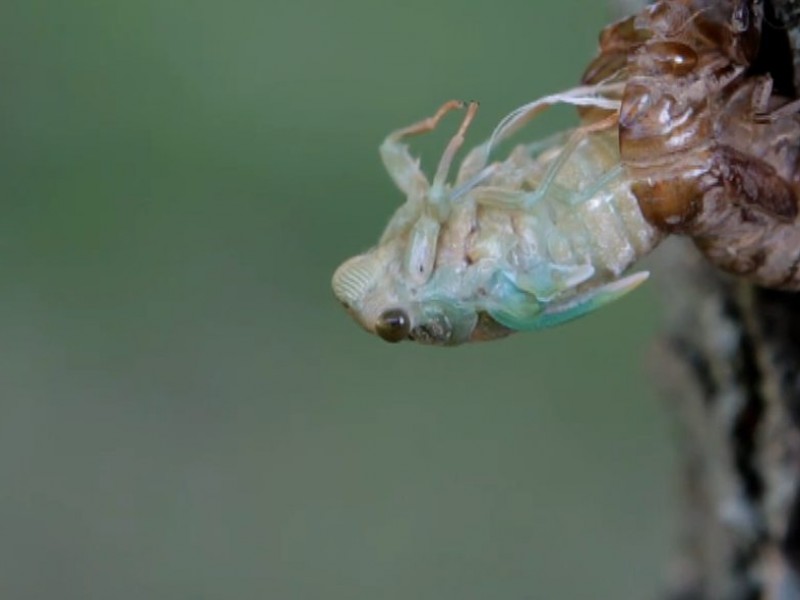

Will the cicadas wreck my plants?Īlmost never. It’s not like a bee sting or something where they come in and nail you.”Ĭooley and Raupp both said they have handled thousands of cicadas and have never been jabbed. “And when they’re piercing bark to lay the eggs, they have to move their ovipositor valves to do that. “When they’re piercing bark to feed, they have to move their mouth parts to drill through the bark,” he said.

“They live in a world where the surface that they live on is made of food, right? So they’ll always just stop and try to feed,” Cooley said.īut cicadas can’t easily break through human skin, and you would have plenty of time to shoo the bug away if you felt one trying. Usually within an hour afterward, the female will search for a tender tree branch, slice into it with her swordlike ovipositor, and lay eggs in the space. There just aren’t enough predators to swallow them all before they reproduce.Ĭicadas have an elaborate courtship ritual that, if a female deems a male worthy, ends in mating. It means they simply “overwhelm the predators by filling their bellies, and there’s still enough left over to perpetuate the species,” said Michael Raupp, an entomologist at the University of Maryland. Scientists call it the predator-satiation defense. Also, they are tasty to pretty much everything, including dogs, birds, reptiles and even some people. Some have killer claws or jaws, some have camouflage, some taste bad or spew poison.īrood X cicadas, however, are lovers, not fighters, and those red eyes aren’t fooling anyone. Why do Brood X cicadas all come out at once?Įvery species has a survival strategy. They may call to find others of their species, or to sound an alarm, but mostly they are trying to attract females. Help protect your home throughout the year with seasonal pest control solutions.When a bunch of Brood X men get together, their chorus can reach 105 decibels - louder than a lawn mower. By doing so you will be prepared for huge numbers of swarming, noisy and periodical cicadas that show up for their scheduled arrival. If you are interested in knowing when the next brood of periodical cicadas is schedule to show up, check out your State’s University Extension Service since they can provide a cicada “forecast” for your area and state. The 17-year cicada broods are designated as broods I through XVII, while the 13-year cicada broods are designated as XVIII through XXX. Populations of periodical cicadas called broods show up in the same areas as their parents who preceded them by 13 or 17 years and cicada experts assign a specific Roman numeral to each brood in order to track and predict their expected emergence. There is some variation since not all members of a population are at the same stage of nymph development and may emerge either ahead or behind their 13 or 17 year schedule – a phenomenon called straggling.

In general, cicadas follow their respective nymph emergent 13 or 17 year time frames. These cicadas emerge from the ground after completing life cycles that are 13 or 17 years. They can be troublesome, but not like the other genus of North American cicadas – Magicicada – the periodical cicadas. These cicada nymphs emerge from their ground habitat in June-August after completing a life cycle of 1-5 years. Most species of cicadas in North America are classified in the genus Neotibicen and are commonly called the annual cicada, jar fly or dog-day cicada. Here the adult cicada emerges, leaving behind the nymphal shell, mating and producing fertile eggs that begin the next generation of cicadas. When the long, underground nymphal stage is complete, mature nymphs burrow upwards to the soil surface and crawl up a tree trunk or some vertical object. The eggs laid by the female cicada begin hatching about six weeks after they are laid and the nymphs drop to the soil surface and burrow underground where they spend almost all of the time it takes to complete their nymphal development. Mature male and female adults mate and the female lays her fertilized eggs in slits she cuts in twigs and branches of trees and shrubs. The cicada’s life cycle is one of incomplete metamorphosis, meaning the insect goes through three developmental stages: To better understand why the appearance of cicadas varies, we need to look at their typical life cycle. The difference relates to when groups of cicada nymphs come out of their developmental habitat in the ground and soon after emergence become flying, mature adult cicadas. If you live in Kentucky, the answer to our question is different than if you live in Pennsylvania. The answer to this question is dependent upon location and the respective species of cicadas that are found there.


 0 kommentar(er)
0 kommentar(er)
